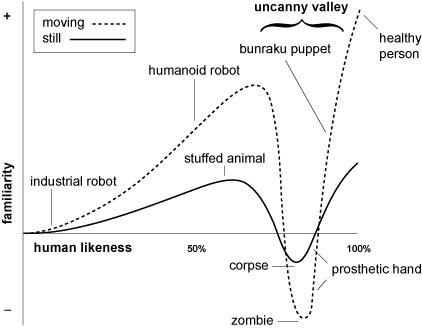We will be proceeding deep into the ‘uncanny valley’, that place where robots looks so like humans, they make us uncomfortable. I have made a reference to the ‘uncanny valley’ in a previous posting that featured some Japanese dancing robots (October 18, 2010 posting [scroll down]). This is an order of magnitude more uncanny. See the video for yourself,
First test of the Geminoid DK. The nearly completed geminoid (twin robot) is operated by a human for the first time. Movements of the operator is reproduced in the robot. (from the description on Youtube)
Here’s a little more from a March 7, 2011 article by Katie Gatto on physorg.com,
The latest robot in the family of ultra-realistic androids, called the Geminoid series, is so realistic that it can actually be mistaken for the person it was designed to look like. The new bot, dubbed the Geminoid DK, was was created by robotics firm Kokoro in Tokyo and is now being housed at Japan’s Advanced Telecommunications Research Institute International in Nara. The robot was designed to look like Associate Professor Henrik Scharfe of Aalborg University in Denmark.
As for why anyone would want a robot that so closely resembled themselves, I can think of a few reasons but Scharfe has used this as an opportunity to embark on a study (from the March 7, 2011 article by Kit Eaton on Fast Company),
Scharfe is an associate professor at Aalborg University in Denmark and is director of the center for Computer-Mediated Epistemology, which pretty much explains what all this robotics tech is all about–Epistemology is the philosophical study of knowledge, centering on the question of what’s “true” knowledge versus “false” or “inadequate” knowledge. Scharfe intends to use the robot to probe “emotional affordances” between robots and humans, as well as “blended presence” (a partly digital, partly realistic way for people to telepresence themselves, demonstrated by weird prototypes like the Elfoid robot-phone we covered the other day). The device will also be used to look at cultural differences in how people interact with robots–for example in the U.S. robots may be perceived as threatening, or mere simple tools, but in Japan they’re increasingly accepted as a part of society.
Here’s a picture of the ‘real’ Scharfe with the ‘Geminoid’ Scharfe,
You can click through to the Geminoid Facebook page from here. Here’s more about Geminoid research (from the Geminoid DK website),
Introduction to Geminoid research
The first geminoid, HI-1, was created in 2005 by Prof. Hiroshi Ishiguro of ATR and the Tokyo-based firm, Kokoro. A geminoid is an android, designed to look exactly as its master, and is controlled through a computer system that replicates the facial movements of the operator in the robot.
In the spring of 2010, a new geminoid was created. The new robot, Geminoid-F was a simpler version of the original HI-1, and it was also more affordable, making it reasonable to acquire one for humanistic research in Human Robot Interaction.
Geminoid|DK will be the first of its kind outside of Japan, and is intended to advance android science and philosophy, in seeking answers to fundamental questions, many of which that have also occupied the Japanese researchers. The most important questions are:
– What is a human?
– What is presence?
– What is a relation?
– What is identity?
If that isn’t enough, there’s research at Georgia Tech (US) being done on how make to robots move in a more humanlike fashion (from the March 8, 2011 article by Kit Eaton on Fast Company),
Which is where research from Georgia Tech comes in. Based on their research droid Simon who looks distinctly robotic with a comedic head and glowing “ears,” a team working in the Socially Intelligent Machines Lab has been trying to teach Simon to move like humans do–forcing less machine-like gestures from his solid limbs. The trick was to record real human subjects performing a series of moves in a motion-capture studio, then taking the data and using it to program Simon, being careful (via a clever algorithm) to replicate the fluid multiple-joint rotations a human body does when swinging a limb between one position and the next, and which robot movements tend to avoid.
Then the team got volunteers to observe Simon in action, and asked them to identify the kinds of movements he was making. When a more smooth, fluid robot movement was made, the volunteers were better at identifying the gesture compared to a more “robotic” movement. To double-check the algorithm’s effectiveness the researchers then asked the human volunteers to mimic the gestures they thought the robot was making, tapping into the unconscious part of their minds that recognize human tics: And again, the volunteers were better at correctly mimicking the gesture when the human-like algorithm was applied to Simon’s moves.
…
Why’s this research important? Because as robots become increasingly a part of every day human life, we need to trust them and interact with them normally. Just as other research tries to teach robots to move in ways that can’t hurt us, this work will create robots that move in subtle ways to communicate physically with nearby people, aiding their incorporation into society. In medical professional roles, which are some of the first places humanoid robots may find work, this sort of acceptance could be absolutely crucial.
It seems that researchers believe that the ‘uncanny valley’ doesn’t necessarily have to exist forever and at some point, people will accept humanoid robots without hesitation. In the meantime, here’s a diagram of the ‘uncanny valley’,

From the article on Android Science by Masahiro Mori (translated by Karl F. MacDorman and Takashi Minato)
Here’s what Mori (the person who coined the term) had to say about the ‘uncanny valley’ (from Android Science),
Recently there are many industrial robots, and as we know the robots do not have a face or legs, and just rotate or extend or contract their arms, and they bear no resemblance to human beings. Certainly the policy for designing these kinds of robots is based on functionality. From this standpoint, the robots must perform functions similar to those of human factory workers, but their appearance is not evaluated. If we plot these industrial robots on a graph of familiarity versus appearance, they lie near the origin (see Figure 1 [above]). So they bear little resemblance to a human being, and in general people do not find them to be familiar. But if the designer of a toy robot puts importance on a robot’s appearance rather than its function, the robot will have a somewhat humanlike appearance with a face, two arms, two legs, and a torso. This design lets children enjoy a sense of familiarity with the humanoid toy. So the toy robot is approaching the top of the first peak.
Of course, human beings themselves lie at the final goal of robotics, which is why we make an effort to build humanlike robots. For example, a robot’s arms may be composed of a metal cylinder with many bolts, but to achieve a more humanlike appearance, we paint over the metal in skin tones. These cosmetic efforts cause a resultant increase in our sense of the robot’s familiarity. Some readers may have felt sympathy for handicapped people they have seen who attach a prosthetic arm or leg to replace a missing limb. But recently prosthetic hands have improved greatly, and we cannot distinguish them from real hands at a glance. Some prosthetic hands attempt to simulate veins, muscles, tendons, finger nails, and finger prints, and their color resembles human pigmentation. So maybe the prosthetic arm has achieved a degree of human verisimilitude on par with false teeth. But this kind of prosthetic hand is too real and when we notice it is prosthetic, we have a sense of strangeness. So if we shake the hand, we are surprised by the lack of soft tissue and cold temperature. In this case, there is no longer a sense of familiarity. It is uncanny. In mathematical terms, strangeness can be represented by negative familiarity, so the prosthetic hand is at the bottom of the valley. So in this case, the appearance is quite human like, but the familiarity is negative. This is the uncanny valley.
It’s a very interesting interpretation of the diagram. The article is definitely worth reading although you won’t find a reference to the zombies which represent the bottom of the ‘uncanny valley’. Perhaps there’s something about them in the original article printed in Energy, (1970) 7(4), pp. 33-35?
ETA April 12, 2011: Someone sent me a link to this March 8, 2011 posting by Reid of the Analytic Design Group. It offers another perspective, this one being mildly cautionary.
